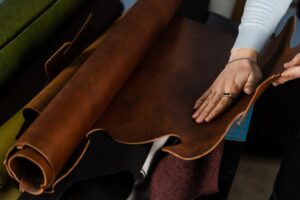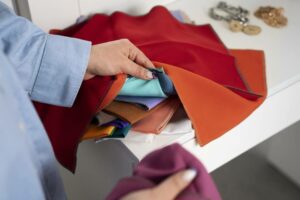When you hear “upholstery furniture,” you might immediately think of aesthetics—how a certain fabric might elevate a room’s design. But there’s so much more to upholstery than just beauty.
Upholstery furniture has a significant impact on the day-to-day life of consumers, ranging from material type to functional advantages.
Let’s delve into the intricate world of natural and synthetic upholstery fabrics and their multitude of benefits.
Natural vs Synthetic Upholstery Fabric

1. Natural Fabric
Natural fabrics are derived from elements present in nature—either plant fibres like cotton and linen or animal-derived materials like wool and leather.
2. Synthetic Fabric
On the other hand, synthetic fabrics are man-made and often crafted through chemical processes.
These fabrics are designed to mimic the properties of natural ones but usually have enhanced durability and resistance to environmental factors.
Read More: Fabric for Sofa: Ultimate Guide to Selecting the Best Material
The Benefits of Natural Upholstery Fabrics

1. The Durability and Comfort of Cotton
Cotton is a household name in the world of natural fabrics. Its resistance to wear, fading, and pilling makes it an excellent choice for upholstery furniture for everyday use.
Cotton is not just durable; it is also incredibly comfortable. Imagine sinking into a plush, cotton-upholstered sofa after a long day—the comfort is unparalleled.
One such example of a high-grade cotton fabric is denim. An extremely durable material, denim is ideal for outdoor upholstery furniture or areas with heavy use.
2. Cotton Blend: A Family-Friendly Option
Cotton blends are just as they sound: a blend of cotton with other fibres. This hybrid approach results in a fabric that is not only durable but also family-friendly.
From checkered prints for that rustic feel to solid hues for a modern vibe, cotton blends come in various options, making them a versatile choice for any upholstery furniture.
3. The Luxurious Elegance of Leather
There’s something timeless about the appeal of leather. Beyond its extreme durability and easy maintenance, leather exudes a sense of luxury that few other materials can match.
A well-maintained piece of leather furniture can last for decades, making it an excellent long-term investment for your home.
4. Linen: Perfect for Formal Settings
Linen is another natural fabric that brings its unique set of advantages. Elegant, breathable, and resistant to pilling and fading, linen is ideal for formal living rooms or adult-only spaces.
However, it’s worth noting that linen may not be the best choice for homes with small children or pets as it can wrinkle and stain more easily than other fabrics.
5. The Delicate Beauty of Silk
Silk is another natural fabric suited for formal, adults-only settings. It is resistant to warping and less likely to rip, offering added durability.
Moreover, it has the advantage of being wrinkle-resistant. However, it’s worth noting that silk is sensitive to sunlight and moisture and relatively delicate, making it unsuitable for frequent use.
6. Vinyl: A Practical Alternative to Leather
Vinyl offers a more affordable alternative to leather and is particularly good for high-traffic areas.
Moreover, not only is it easy to maintain, but it’s also child and pet-friendly, resisting scratches and easy to clean.
Marine vinyl, particularly, is highly water-resistant and durable, making it ideal for marine environments and standing up well to sun and water exposure.
7. Wool and Wool Blends: The All-Rounder
Wool and wool blends offer robust durability. They are resistant to pilling, wrinkling, soil, and fading.
What’s more, blended wools are often easier to maintain, combining wool’s best qualities and synthetic fibres for a versatile upholstery fabric that stands the test of time.
Read More: Pocket Spring Sofa: Your Complete Guide to Sofa Springs
The Practical Advantages of Synthetic Upholstery Fabrics

1. Acetate: The Humidity Fighter
Ideal for humid climates and lesser-used furniture, acetate resists mildew, pilling, and shrinking.
Although not as durable as other options, its specific advantages make it a worthy choice for certain applications.
2. Acrylic: The Outdoor Champion
Acrylic fabric mimics the softness and texture of wool but offers superior durability and resistance to moisture and fading.
This makes it a great option for outdoor upholstery furniture, standing up well to the elements while providing cosy seating.
3. Microfibre: The Durable Softie
Microfibre combines a velvet-like texture with high durability, offering water, stain, and fade resistance.
Its unique composition makes it one of the most resilient upholstery options, perfect for homes that want both luxury and longevity.
4. Nylon: The Commercial Favourite
Nylon is a powerhouse when it comes to strength and resilience, making it a common choice for commercial applications. It’s often blended with other fibres to enhance its natural durability.
5. Olefin: For Heavy Duty Use
Olefin is highly durable, making it ideal for heavy-duty furniture, whether used indoors or outdoors. It is also resistant to fading and staining from frequent use and exposure to sunlight.
Additionally, olefin is capable of resisting mildew, which simplifies maintenance and makes the furniture safer to use.
6. Polyester: Easy Maintenance and Variety
Polyester fabrics are often blended with other fibres to boost their innate resilience, making them resistant to wrinkles and easy to maintain.
They also come in a variety of colours and are a versatile choice for any household.
Notable examples of durable blends include chenille and coquet, which are both robust poly-cotton combinations designed for heavy-use furniture.
7. Rayon: For Family Homes
Rayon is a smooth, cool fabric that is perfect for homes and high-traffic spaces.
Not only is it highly durable and breathable, but it also boasts wrinkle-resistant qualities, allowing it to maintain its appearance over time.
What to Consider When Choosing Fabric for Upholstery Furniture

1. Location of the Furniture
Firstly, think about whether the furniture would be placed indoors or outdoors. Outdoor furniture will need tougher upholstery.
2. Expected Wear and Tear
Next, estimate the wear and tear based on usage. High-traffic areas or homes with children or pets require more durable fabrics.
3. Maintenance Requirements
Additionally, factoring in maintenance frequency and ease of cleaning is crucial for optimising business operations. For high-traffic commercial spaces, consider upholstery materials that offer easy and low-cost maintenance.
4. Aesthetic Preferences
Lastly, you would want to think about the space’s overall aesthetic. Pick colour schemes, textures, and patterns that would go well with each other or make certain room elements pop.
Elevate Your Lifestyle with Kintex’s Quality Upholstery Fabric
Selecting upholstery goes beyond mere aesthetics; it’s an investment in enhancing a space and the well-being of its occupants.
From the unparalleled luxury of leather to the robust versatility of synthetics, there’s a fabric that perfectly suits your needs.
As the leading supplier in Malaysia, Kintex is here to provide only top-quality upholstery fabrics for your furniture.
Explore our comprehensive fabric collection and delve into our PU & PVC leather collection for more.







